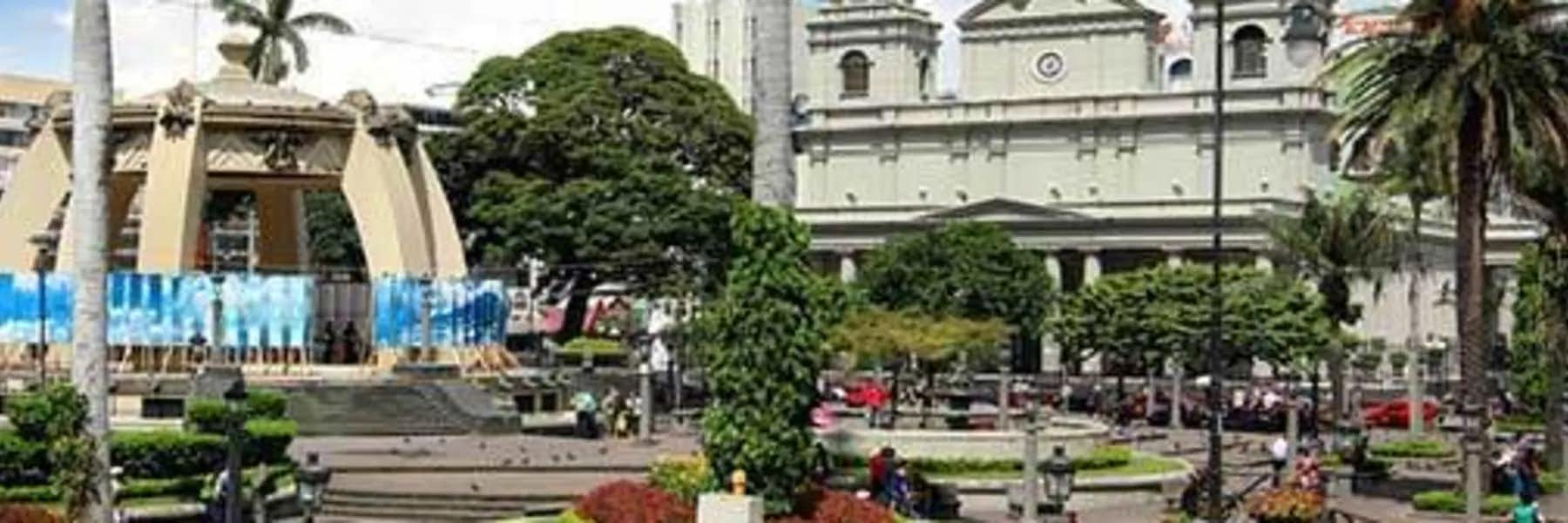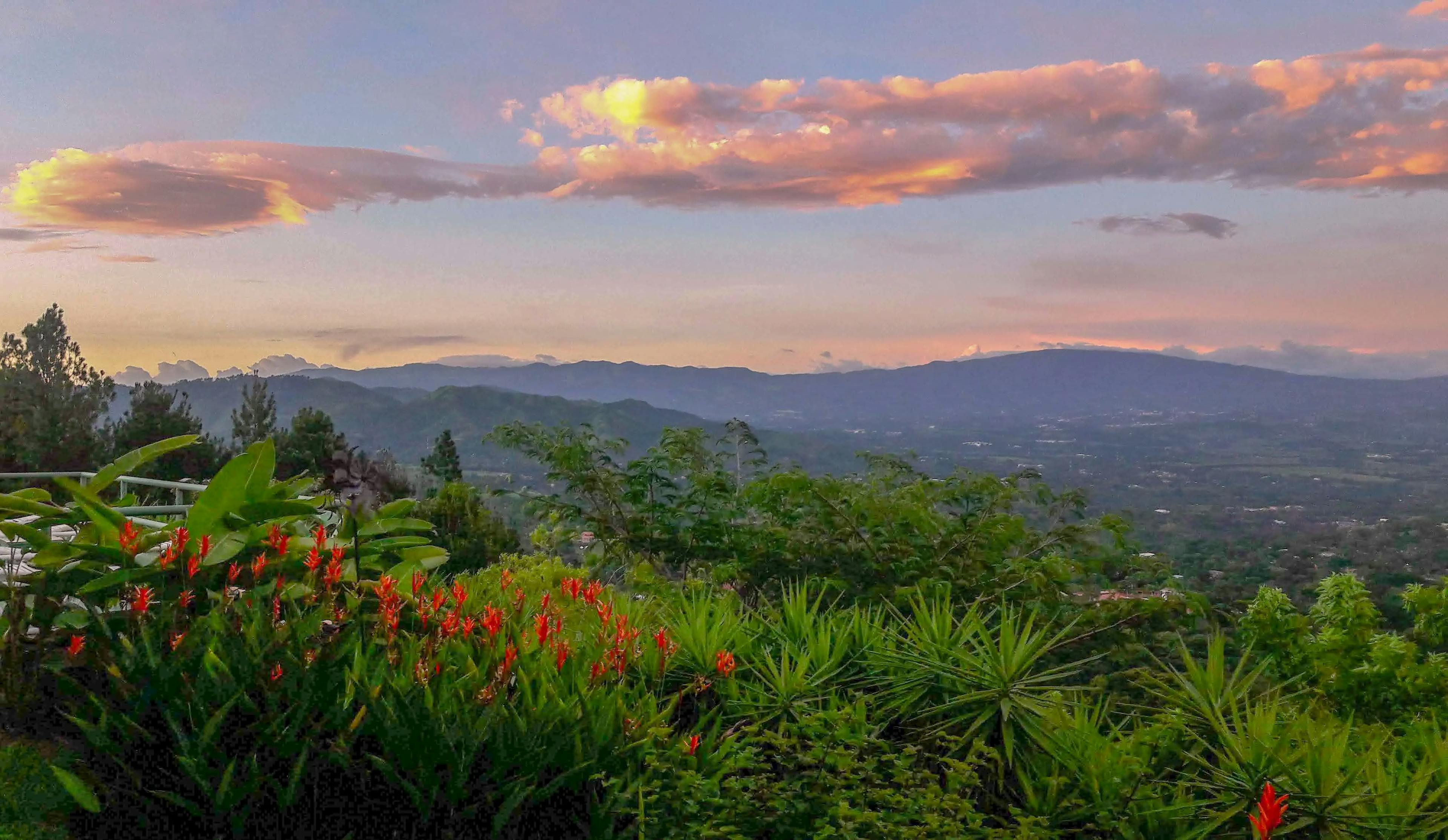By Lou Kritz
In the center of the Central Valley of Costa Rica, and thus the country, lies a gem that most Norte Americanos miss as they rush around the country to see the beaches, rain forests, hot springs at the volcanos, and small cities scattered just about everywhere. That gem is San José, the capital and largest city in the nation.
San José is the center of the national government, the focal point for political, economic, educational activity, and is a major transportation hub for both the country, and all of Central and South America. The almost 2.5 million people of the Greater Metropolitan Area, which includes Alajuela, Heredia, and Cartago, appreciate the special place they inhabit.
At an elevation of 3,845 ft., the weather is always comfortable, with a daytime high average of 83 F, and an evening low average of 66 F, which vary only by three degrees year-round. Mid-November through April is the dry season of very limited rainfall, and May through October is the wet season, with generally daily periods of rain.
The city was founded in 1736 while under Spanish domination, and was named the capital in 1820. It began to develop into a major location as the coffee and tobacco industries bloomed in the nearby agricultural areas. The infusion of capital from these endeavors was put to incredibly good use in one of the first cases of aggressive urban planning.
San José is a city of barrios, or planned neighborhoods built slowly over centuries, that exhibit different architectural styles and personalities. These remain today as cultural and social centers. Upscale Barrios Amón and Aranjuez, the oldest in the city, are home to many of the city's most elegant and historic buildings.
Interestingly, many rural residents of the country avoid this masterpiece city. Ask a tico about San José and he'll tell you to stay away. He says it is dangerous, crowded, and you'll get robbed. After many excursions into the capital, visitors find that none of this is the case. It is a bright, open, welcoming metropolitan host to both citizens and tourists. In fact, studies of Latin America have proclaimed San José one of the least violent and safest cities, as both the city and country have annually reduced the crime rates.
Since 2006 the city has been included as an Ibero-American Capital of Culture, thus being recognized by other major cities in Central and South America. It is considered a "Beta"—global city by GaWC that is instrumental in linking this region into the world economy. It is the sixth-most visited city in Latin America, and the most-visited in Central America. So, the point of all of this? San José is a great place to visit or live!
Get Your Free Costa Rica Report Here
Get Your Free Costa Rica Report Here
Learn more about Costa Rica and other countries in our daily postcard e-letter. Simply enter your email address below and we’ll send you a FREE REPORT - Explore the Old World in Laidback Costa Rica.

By submitting your email address, you will receive a free subscription to IL Postcards and special offers from International Living and our affiliates. You can unsubscribe at any time, and we encourage you to read more about our Privacy Policy.
Retire in San José, Costa Rica
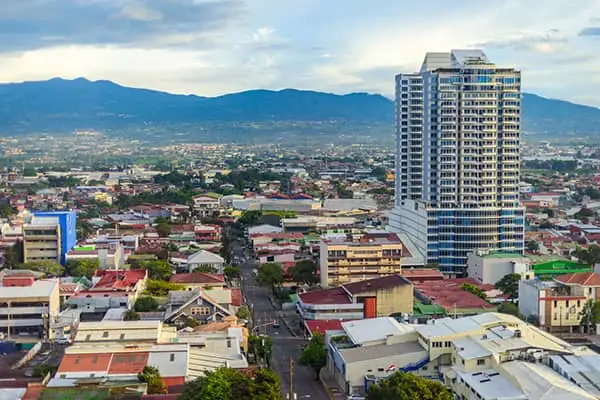
One word that describes the retirement potential in San José is "options." Without a doubt, all of the outlying areas of Costa Rica have some special features, and often multiple features, that will attract new residents. However, if you prefer a more active, vibrant lifestyle, no place offers it like San José. You can choose history and spend months or years understanding this town. Educational opportunities abound, related to both the University of Costa Rica, headquartered here, or the multitude of private schools offered at all levels.
As the city is the transportation hub, travelers are served well. The Juan Santamaria International Airport is 14 miles to the west of the center city in Alajuela, and is rated one of the best in Latin America/Caribbean by the Airports Council International. The six million passengers going through annually are traveling back and forth to and from the U.S., the Caribbean, South America, and Europe. There are also commuter flights to just about all of the country's mid-sized cities.
There is a commuter rail system that serves the Metropolitan Area, just recently upgraded with eight new trains that double the system's capacity. From Paraiso and Cartago east of the city to Alajuela and Ciruelas to the west, the routes meet at the San José hub. Construction has begun with a line connecting the eastern route with an international link to Panama's system. The second phase will be the northwest expansion to the Nicaraguan border.
Costa Rica has an amazing bus system, and San José is the key element of it. Most smaller towns have local routes that are served at one-half, or one-hour, intervals. Mid-range busses go further, and long-range lines go border to border. It's relatively easy to take a mid-range coach to a terminal in San José, then transfer to a line going just about anywhere in the country. A bonus is the over-65 Gold Card which means seniors ride free on local busses and most mid-rangers, at half price on the long hauls.
Taxis are used extensively. The government controls the red taxis with the yellow door triangles by setting the rates and monitoring service. Use of these is highly recommended because they are very economical and safe. There are gypsies, which are called piratas, or pirates, and should be avoided.
Housing is as varied as anyone could want. Rentals of both apartments and houses are plentiful, along with a greatly diverse supply of salable properties should you decide to buy. Pricing is generally slightly higher than asking prices in outlying towns. However, with the availability of just about every service or amenity you could desire, coupled with their easy accessibility, makes the city's prices quite reasonable.
Costa Rica is known for an outstanding medical system, consistently rated in the top four worldwide. CAJA (ka-hah) is a government-backed program, and maintains a center-city medical park of five general and specialized hospitals, and a large number of community clinics. There are also many private hospitals, supported by the independent medical community.
Lifestyle in San José, Costa Rica
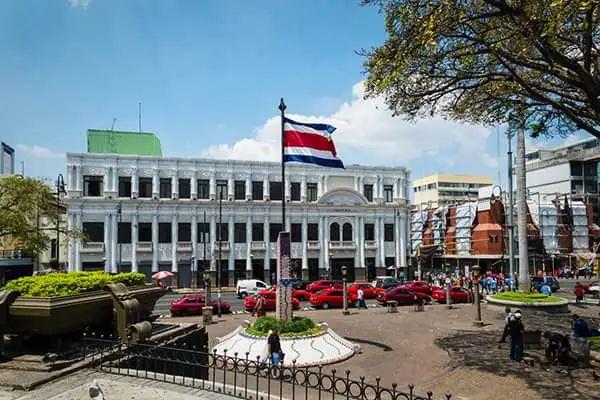
Even though there is more of a big city atmosphere in San José, you can still live peacefully and stress-free. The reason is that there are at least nine well-defined barrios that are culturally significant. In the early development of the country, San José was a small city surrounded by growing villages and towns, known as barrios. As the population increased and the metropolitan area came to life and filled vacant spaces, the barrios were merged into what has become today's major city.
The interesting occurrence was that these communities were not dissolved and merged into one society but rather, held onto their own special traits, quirks, and vibes. Today, you can go from Barrio Amón, the oldest highlighted by magnificent colonial architecture, to Barrio Rohrmoser, the location of the U.S. Embassy, and filled with expats and professionals. In San Pedro, you can experience all types of restaurants, from sodas, small, home-prepared Costa Rican meals to fine dining of all types.
There is no shortage of shopping opportunities. Center-city stores range from small specialty offerings to larger department stores of all price ranges. As you venture outward from the pedestrian mall in mid-town, you will see malls, and specialty stores to explore.
With the impressive center pedestrian mall, unique barrios, and quaint neighborhoods, dining is a daily adventure to find your new favorite. Most restaurants are locally owned, even some of the finest upscale ones. It's here that you find the blending of cultures that make dining out fun and interesting. For example, a side dish of mangos, pineapples, and strawberries may accompany your eggplant parmesan at Marios.
For your own kitchen stocking excursions, you'll find San José has a Mercado Central, or Central Market, open daily, as well as the weekly feria, the farmers' market, with Costa Rica's outstanding homegrown produce, meats, cheeses, and just about anything else to make your meals healthy and delicious.
Cost of Living in San José, Costa Rica
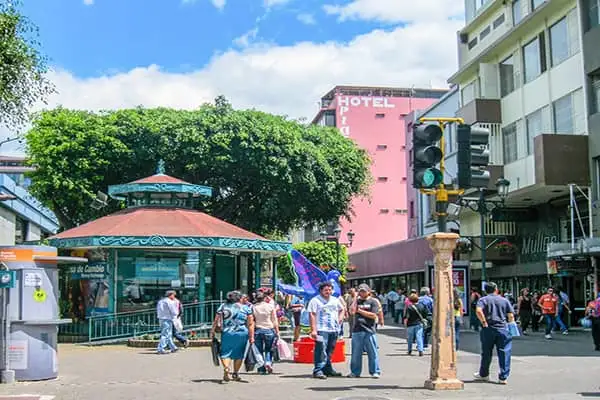
Because of so many options in all areas of your cost of living, and the interesting choices you can make, costs are presented as a range. The barrios vary in styles, types, and availability. Then, within each one are different areas that affect the prices for just about everything. Following are monthly rates, basically for two people.
| Expense | U.S. $ |
|---|---|
| Rent | $600 to $2,200 |
| Utilities (electricity, water, phone, TV, and gas) | $100 to $300 |
| Groceries | $400 to $800 |
| Household help & incidentals | $115 to $305 |
| Medical costs | $150 to $550 |
| Dining and entertainment | $108 to $224 |
| Transportation | $120 to $530 |
| Total: | $1,593 to $4,409 |
Notes:
Rent for a one-bedroom, one-bathroom apartment in Escazu, to a luxury three-bedroom house in Santa Ana.
Utilities—save by using a prepaid cell phone, rather than a high-priced monthly plan.
Groceries can be the biggest money savers by shopping locally at markets, the feria, etc., and avoiding the import grocers that must pay 20% to 69% import duties.
Household help allows for one weekly cleaning visit and basics on the low end, to two visits on the high end.
Medical costs start with CAJA and some incidentals versus private insurance and independent doctors services.
Dining & entertainment starts with one restaurant meal at a local family-style, and one lunch at a soda, for two, per week. Add two fine-dining outings per month for the higher figure.
Transportation compares three roundtrip busses plus two taxi rides per week, with the costs of owning a car. The car's costs are the annual registration, Marchamo, the annual inspection, Riteve, insurance, repairs, and fuel, one tankful per week of gas or diesel. The Marchamo and Riteve, although yearly, have been quoted at monthly rates. Not included, however, is the car's purchase price, which is generally 30% to 50% higher than the U.S., due to the import duties.
This chart shows that lifestyle choices can make a difference in living costs. The balancing factor is the incredible availability of free and low-cost attractions and entertainment. Many museums are free, or low-cost to residents, food at interesting dining spots is very reasonable, and concerts and fiestas abound, many at no charge.
Get Your Free Costa Rica Report Here
Get Your Free Costa Rica Report Here
Learn more about Costa Rica and other countries in our daily postcard e-letter. Simply enter your email address below and we’ll send you a FREE REPORT - Explore the Old World in Laidback Costa Rica.

By submitting your email address, you will receive a free subscription to IL Postcards and special offers from International Living and our affiliates. You can unsubscribe at any time, and we encourage you to read more about our Privacy Policy.
Things to Do in San José, Costa Rica
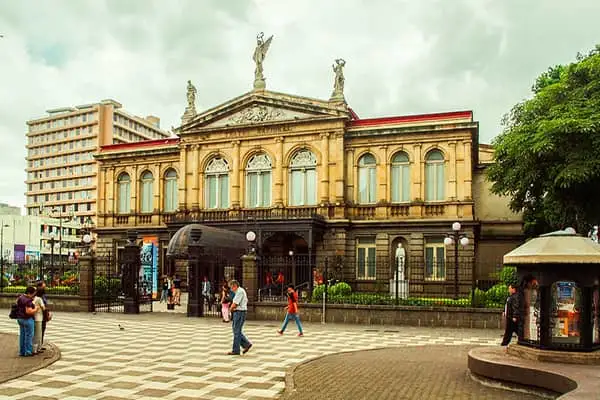
Get to Know the Heart of This Great City
Costa Rica has almost unimaginable beauty in its beaches, mountains, inland towns, people, and history. The list goes on. It's all tied together, however, in the unique avenida Central, or Central Avenue pedestrian mall. In two miles, about 25 blocks, the creators have managed to showcase the nation's history, the tico work ethic, architecture, art, shopping, the medical system, and more.
This is an area that you will visit once as a tourist, then many times once you become a resident.
See True Gold that Columbus Missed
The Pre-Columbian Gold Museum is located at the start of the Central Avenue Mall. You'll see a plaza, the Plaza de la Cultural, or Cultural Plaza as a place to rest while touring. You will find that it is actually the roof of a three-story building deep in the earth. Each floor is a separate museum, beginning with the Museo Numismático, National Coin Museum. Then step down to the museum of Costa Rican art, and the Gold Museum on the lower level. Here you can view over 3,500 Pre-Columbian gold, stone, jade, and glass archaeological finds created from 300 BC to 1550 AD.
Tour the Barrios
Neighborhoods, or barrios, make up the city. Visiting them provides a view of their history and architecture and lays the groundwork for your eventual residence. Begin with Barrios Amón and Aranjuez, the oldest, then San Pedro, Los Toses, and Escalante to the east, and find eventually finish at La Sabana, Rohrmoser, Escazu, and Santa Ana to the west.
Learn About Learning
The University of Costa Rica, headquartered in the San Pedro Montes de Oca section of San José, is the focal point of the best university system in Latin America. Over 42,000 students attend the schools of UCR, and four other public universities. A visit here showcases the history and modern-day advances of the nationwide system of top-flight schools.
Asia in Latin America
Bordering the south edge of the Central Avenue mall is the small but growing Chinatown. After having to overcome resistance for many years, the Chinese community of expats is now seen as a welcome addition to San José's inclusive culture. Enjoy the quality Chinese restaurants, unique stores, and a relaxing demeanor.
Art, Airplanes, Fútbol, and Air
At the west end of the mall is Sabana Park, considered the "lungs" of San José. This is because of the efforts that have been made to keep it green and fresh with trees, open areas, and plants. From 1930 to 1974 the plan was interrupted by the operation of La Sabana International Airport until the opening of today's jetport in Alajuela.
Fronting the park is the Museo de Arte Costarricense, or Costa Rican Art Museum, housed in the former terminal building and control tower. It is known as an outstanding presentation of Costa Rican art. At the western end is the National Stadium of Costa Rica, a World Cup-level facility funded as a gift to the country by the Chinese government of Hu Jintao in 2009. Enjoy football (soccer), track events, and top-level concerts.
Go For it and Explore!
One of the most amazing activities is to jump on the bus or a train and just find out where they go. San José's central hub status makes it easy to see the surrounding areas and discover the unique beauties and unexpected treats of this amazing country. Bus drivers and train conductors are knowledgeable and will answer questions about the routes, return schedules, and sights to see. Short excursions will cost less than two dollars, and longer ones may set you back five. Such a deal!
The Heart of San José, Costa Rica
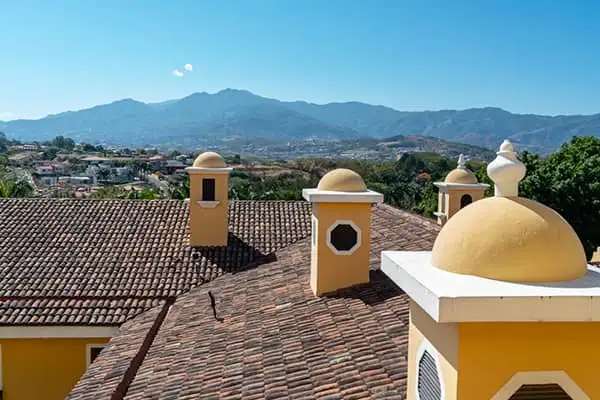
San José is home to an extraordinary treasure that most tourists miss as they travel to beaches, volcanos, charming towns, and many other of the country's riches. It is the avenida Central, or Central Avenue.
Central Avenue has become a no-traffic promenade allowing easy strolling and an abundance of shopping opportunities, as well as a host of interesting sights and historical treasures. Difficult to see in one day, you will find yourself strolling these no-traffic streets often. Fortunately, attractions tend to be in groups interspersed with parks and ever-present welcoming benches for the rest stops, so you can plan your day to see a group, then head off in another direction for later hours.
Begin your tour near the eastern end of the Central Mall at about calle 19, 19th street. The National Park dates back to 1892 when the nation was selecting the site for the National Monument. This statue commemorates the defeat of William Walker, a U.S. North American who attempted to conquer all of Central American for slavery with a plan to add it to the U.S. Confederacy. Walker was stopped by the Costa Rican army commanded by president Juanito Mora. The hero of the battle was Juan Santamaria, a 24-year old soldier who torched the enemy's hideout, before being fatally wounded. The international airport is named in commemoration of Santamaria.
The statue of Santamaria was installed on September 15th, 1895, inaugurating the National Independence Day, and Costa Ricans have celebrated on this date every year since. Around the park, shaded by the beautiful Savanna Oak Trees, are the Congressional buildings, the historic Distillery Complex, the Supreme Electoral Tribunal, and the National Library.
A short walk takes you to the Army's Abolition and Democracy Plaza, its new name commemorating the 1948 abolishment of the country's army by José "Pepe" Figueres Ferrer. This made Costa Rica the only country in the Americas without armed forces, a condition that remains today.
The Bellavista Fortress overlooking the Plaza houses the National Museum and was the site of the last civil war battle.
The massive collection of natural jade artifacts is next on your eastward stroll. The Jade Museum houses jade items representative of every indigenous society from 500 BC to 800 AC. Archaeological excursions have found the jade, along with many examples of ceramic objects, like bowls, plates, rattles, and flutes.
The Plaza de la Cultura, the Cultural Plaza, is a surprise. What appears to be a street-level open space to rest and relax, is actually the roof of a building that is three stories deep. Enter the Art Museum first, then descend to the Numismatic Museum, and finally, find yourself in the breath-taking pre-Columbian Gold Museum. The gold artifacts are from various time periods and somehow escaped Spain's pillaging policies when they occupied Central America.
Overlooking the Plaza is the architecturally perfect and lavishly appointed National Theater. The theater presents a regular schedule of symphonic and operatic performances, and well as offering tours during non-performance hours.
Wandering westward you will meet La Cholla, a huge bronze statue by Manúel Vargas of a very matronly Costa Rican woman, honoring the rich heritage in the country of the mothers, grandmothers, ladies, and lovers that hold the country together. Note the shiny bronze areas of the statue. It is perfectly permissible to say hello to La Cholla by giving her a pat or a rub in one of these special places.
As you walk through all the history and architecture, don't forget to visit two of the most unique, modern-day, shopping opportunities. The San José Central Market is the daily shopping venue for many citizens, and it's become a meeting place, a wholesome farmers' outlet, and a renowned place for good eats. Almost every town in Costa Rica has a mercado like this, but this one is outstanding.
Pairing up shopping interest is the Municipal Craft Market a few blocks away. It showcases local artisans, craftsmen, and indigenous natives' tribal art forms. It's a great stop for authentic remembrances of your trip.
Arrive at the Central Park of San José and trek in a three-block circle from there. You'll find the Casa Jiménez de La Guardia Italian Art Nouveau home, built in 1905, by architect Francesco Tedrazzini, part of the country's National Historical Heritage. Continue on to the Melico Salazar Theater honoring Costa Rica's most famous opera and classical tenor, who died in 1950. The theater continues on, offering a full schedule of concerts, operas, and other musical events.
A block south offers the Metropolitan Cathedral of San José, built in 1805, but destroyed in an earthquake. It was rebuilt in 1871and continues to showcase its outstanding architecture and beauty. The cathedral is just a short walk from the Main Post Office, a late neoclassical-style building dating to 1917. It is still fully operational, and offers a walking tour and a philatelic museum.
The last stop in this cluster of history and beauty is the sculpture, Monumento A Los Presentes. It is a bronze sculptural ensemble of nine life-size peasant figures, representing the hard workers who built the country, and legend has it that these folks are standing firm against modernization.
In about a nine square block area as you continue on Avenida Central, you will come to an area known as the Hospital Center. It is home to four hospitals of CAJA, the Spanish acronym for the national health system. They are: the National Children's, the Geriatrics and Gerontology, the San José de Dios General, and the Transporte Hospital San Juan de Diós, plus the private Hospital Metropolitano. A walk-through will show the advanced and modern treatment facilities that cause Costa Rica to be ranked at about number four in the world for excellence in healthcare.
The end of the downtown area is considered to be Sabana Park where Paseo Colon turns onto Calle (Street) 42, or route one. This is the home of the Costa Rican Art Museum and is well worth a visit, with a quality permanent museum and a full schedule of temporary exhibits.
At the far end, Sabana Park contains the national football (or soccer, for the gringos) stadium. But more importantly, this used to be the airport for the city, and the art museum resides in what was the terminal and tower.
The tour is complete, but come back to experience more tourist sites, more shopping opportunities, and a plethora of fine dining options. Avenida Central has it all.
Get Your Free Costa Rica Report Here
Get Your Free Costa Rica Report Here
Learn more about Costa Rica and other countries in our daily postcard e-letter. Simply enter your email address below and we’ll send you a FREE REPORT - Explore the Old World in Laidback Costa Rica.

By submitting your email address, you will receive a free subscription to IL Postcards and special offers from International Living and our affiliates. You can unsubscribe at any time, and we encourage you to read more about our Privacy Policy.
Five Cultural Attractions to Enjoy in San José, Costa Rica
For many visitors and even many expats who’ve lived in Costa Rica for years, the country’s capital, San José, remains a very utilitarian destination, so to speak.
As the commercial center, it’s the place go for the best shopping in the country. If you can get it in Costa Rica, it’s in San José. And as the governmental center, when you’re going through the residence process…you end up in San José. With the top hospitals and most specialists, it’s also the best place for medical care.
But San José is also the heart of culture in the country, with a lot to recommend it across many disciplines and art forms. For residents of the Central Valley, the region which surrounds San José, a trip into the city for cultural activities is well worth a day trip or night out on the town. Those further out could make it a weekend trip. Below are five cultural experiences to enjoy in San José.
1. The Classics
If you’re a fan of opera, classical music, ballet, modern dance, and jazz…look no further than the National Theater in downtown San José. Drawing national and international acts, this historic building, dating to the 1800s, is fully-restored inside and out and is considered one of the most beautiful buildings in the country. Tickets for primetime performances start at $10. And noontime shows during the week are as low as $2 for those over 65.
2. Theater
For an English-language theater, you can check out the Little Theatre Group of Costa Rica, which is made up of expat amateur actors (newcomers welcome). Past productions at the Little Theatre include One Flew Over the Cuckoo’s Nest and Shakespeare’s Twelfth Night. Drama with professional casts can also be found at Teatro Eugene O’Neil and Teatro Laurence Olivier, with performances in Spanish and English.
3. Museums
The capital also hosts several world-class museums. Not on the level of Paris or London perhaps, but worth a visit. The National Gallery recently played host to an exhibition of works by Picasso, Warhol, Renoir, and more. There are also museums that pay tribute to pre-Columbian artifacts and artworks created in jade and gold—the Jade Museum and Gold Museum respectively. It’s amazing what the indigenous peoples of Costa Rica created hundreds of years ago with primitive methods.
4. Festivals
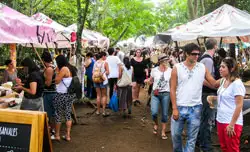
Every year, usually in April, the Festival de las Artes offers a week-long gathering of artists and performers from around the world. Performances take place on stages set up in La Sabana, San José’s main central park near downtown. Artists and craftspeople also exhibit their work, often for sale. And performance artists, puppeteers, musical groups, and more perform at the park and at venues throughout the city. The schedule can be a bit overwhelming. But the caliber of performers makes it worth braving the crowds and checking out at least one or two days
5. Concerts
As a major city in Central America, San José is also a tour stop for many musical artists on international tours. Aside from Latin favorites like Juanes, recent performers have included Lady Gaga, Paul McCartney, Aerosmith, and Elton John. The venue is usually the National Stadium in the aforementioned La Sabana park. But the stadium of the Saprissa soccer team across town is also used.
Safety in San José
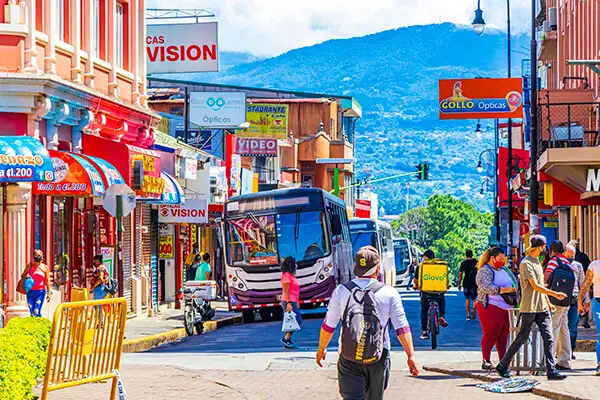
The most often asked, and most incorrectly answered, question about San José is "Is it safe?" To accurately assess the facts, there are many areas of research that can help, from international organizations, government studies, and police records.
San José is the number one city in the Central Valley and the whole country. It is the capital of Costa Rica and is home to the government headquarters, the financial center, and the major transportation hub, including air, rail, public buses, and auto travel. It is also where you can find the best healthcare and education institutions, both public and private.
San José is a city built around both history and architecture. What started as small, independent barrios, or small villages, eventually grew together into a large urban environment. You’ll find major museums here, along with the national theater and the Central Avenue Boulevard—the center of monuments, stores, markets, dining, and many other entertainment options. The vibe in San José could be described as very active and current in terms of political, medical, corporate, and commercial happenings. It is also exciting while offering visitors and residents the ability to live in a quiet, beautiful barrio for those times when peace and quiet are desired.
For the tourist or prospective resident, San José provides a centralized introduction to all the city and country has to offer. Unfortunately, many visitors to the country land at the airport and immediately board their transportation to the beach or a mountain volcano resort, missing a magnificent showpiece, often because of misguided information.
On the international front, studies of Latin America have proclaimed San José to be one of the safest and least violent cities. Since 2006 the city has been listed as an Ibero-American Capital of Culture, and is recognized by other leading Central and South American major cities. It is the sixth most visited city in Latin America, and the most visited in Central America.
The Ga-WC, a study organization at the Geography Department of Loughborough University in England, rates San José as a "Beta" city, or one that is instrumental in linking their region to the world economy.
The Costa Rican government is very aggressive when it comes to safety and criminals. Most police are nationally sponsored so they can be deployed rapidly. The largest forces include the OIJ, an investigative arm of the judicial branch, which sometimes works undercover. They are accompanied by the Ministry of Transportation Traffic Police, who work the roadways exclusively. The DIS is the intelligence service that can be compared to the U.S. Federal Bureau (FBI).
In 2007, concerned about safety for visitors and shoppers in San José's Avenida Central, or Central Avenue, the heart of shopping, museums, the arts, medical centers, and the government, Costa Rica created the policia turistica, or tourist police, to stem the tide of petty crimes that tend to follow unaware vacationers and relaxed travelers. This service has grown and they show up on foot, bicycles, and even horseback at the airport, amusement venues like the National Futbol Stadium, and at malls.
After researching and studying all of this, about four years ago, my wife Loraine and I couldn't wait to see San José for ourselves. We were aware that the city and country are not crime-free. Avoiding petty crime, like pickpocketing, purse snatching, and petty theft demand some attention. A few pointers: Be aware of your surroundings. Don't walk alone after dusk, unless there are a lot of people in the area. Leave your car locked, and empty of valuables. An exposed camera on the back seat is a target. It is good practice to avoid putting bags of purchases in overhead bus racks. Most buses have seats with plenty of leg room that will accommodate them. Do not flash cash, looking like a spendthrift tourist. Guard against pickpocketing by carrying as few credit cards as possible.
Try this trick. The stores here sell a wallet that is a simple bifold holder. It is just big enough to hold a plastic credit card in each side, then folds. In mine, I carry my cedula, or national I.D. card, my bank debit card, a credit card, my medical I.D., and a couple small bills. Since I wear jeans mostly, I push it in my front pocket and twist it so a fast swipe can't retrieve it. My wife wears a very small shoulder purse strapped over her body, with a hand resting on it.
If you find yourself out after dark, there are always cabs. Call one yourself, or, better yet, ask the restaurant owner or shopkeeper to do it. They will not only comply, but will make you sit inside until the cab arrives, then will walk you to the car.
My wife, Loraine and I finally succumbed to our desire for a new adventure and decided to celebrate her birthday in the heart of downtown. Our tico landlord’s oldest son, who lives next to us, told us not to take cash. "You'll only be robbed." The landlord himself insisted that he be allowed to deliver us to our 4-star hotel on Central Avenue.
We spent four glorious days traversing the grand promenade, along with hundreds or thousands of other people, during the day. Nights were spent mostly in the hotel. But, they had a beautiful pool, a relaxing hot tub, several late-evening cafes, and a casino. Early darkness caught us twice at restaurants five or six blocks away from our hotel. Those nights we cabbed it back for a $0.85 fare each time.
Now, our favorite getaway spot is San José.
Featured Image Copyright: ©iStock/E_Rojas
Get Your Free Costa Rica Report Here
Get Your Free Costa Rica Report Here
Learn more about Costa Rica and other countries in our daily postcard e-letter. Simply enter your email address below and we’ll send you a FREE REPORT - Explore the Old World in Laidback Costa Rica.

By submitting your email address, you will receive a free subscription to IL Postcards and special offers from International Living and our affiliates. You can unsubscribe at any time, and we encourage you to read more about our Privacy Policy.
